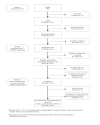Obstetric risk indicators for labour dystocia in nulliparous women: a multi-centre cohort study
- PMID: 18837972
- PMCID: PMC2569907
- DOI: 10.1186/1471-2393-8-45
Obstetric risk indicators for labour dystocia in nulliparous women: a multi-centre cohort study
Abstract
Background: In nulliparous women dystocia is the most common obstetric problem and its etiology is largely unknown. The frequency of augmentation and cesarean delivery related to dystocia is high although it is not clear if a slow progress justifies the interventions. Studies of risk factors for dystocia often do not provide diagnostic criteria for the diagnosis. The aim of the present study was to identify obstetric and clinical risk indicators of dystocia defined by strict and explicit criteria.
Methods: A multi-centre population based cohort study with prospectively collected data from 2810 nulliparous women in term spontaneous labour with a singleton infant in cephalic presentation. Data were collected by self-administered questionnaires and clinical data-records. Logistic regression analyses were used to estimate adjusted Odds Ratios (OR) and 95% confidence intervals (CI) are given.
Results: The following characteristics, present at admission to hospital, were associated with dystocia during labour (OR, 95% CI): dilatation of cervix < 4 cm (1.63, 1.38-1.92), tense cervix (1.31, 1.04-1.65), thick lower segment (1.32, 1.09-1.61), fetal head above the inter-spinal diameter (2.29, 1.80-2.92) and poor fetal head-to-cervix contact (1.83, 1.31-2.56). The use of epidural analgesia (5.65, 4.33-7.38) was also associated with dystocia.
Conclusion: Vaginal examinations at admission provide useful information on risk indicators for dystocia. The strongest risk indicator was use of epidural analgesia and if part of that is causal, it is of concern.
Figures
References
-
- Cluett ER, Pickering RM, Getliffe K, St George Saunders NJ. Randomised controlled trial of labouring in water compared with standard of augmentation for management of dystocia in first stage of labour. BMJ. 328:314. doi: 10.1136/bmj.37963.606412.EE. 2004 Feb 7; Epub 2004 Jan 26. - DOI - PMC - PubMed
Publication types
MeSH terms
LinkOut - more resources
Full Text Sources


